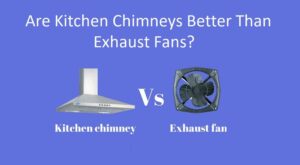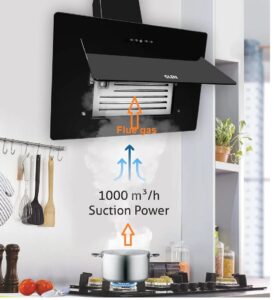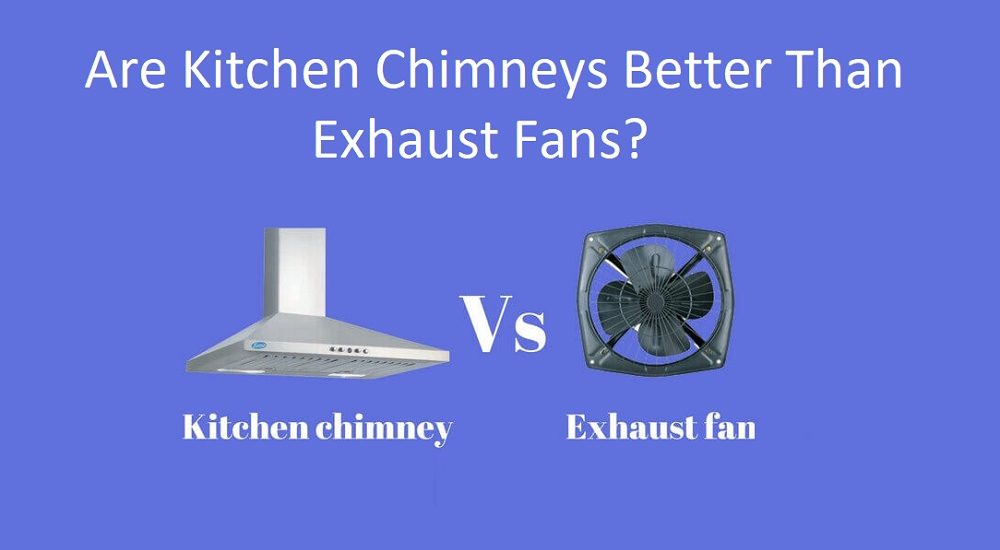Exhaust Fan for Kitchen
An exhaust fan is a small ventilating device fitted on the kitchen wall or window. Its main job is to expel hot air, smoke, steam, and light fumes outside, improving airflow in the kitchen.
Advantages of Exhaust Fan in Kitchen
- Low Cost – Very affordable (₹800 – ₹2,000).
- Simple Installation – Needs only a wall/window opening and electricity connection.\
- Low Power Consumption – Runs on 40–70 watts, very energy efficient.
- Easy Maintenance – Only occasional cleaning of blades required.
- Improves Ventilation – Helps circulate fresh air, reduces humidity.
- Compact Size – Takes very little space compared to a chimney.
- Durable – Basic design, long life, fewer breakdowns.

Limitations of Exhaust Fan in Kitchen
- Cannot Trap Grease/Oil – Smoke and oil particles still stick to tiles, cabinets, and ceiling.
- Less Effective for Heavy Indian Cooking – Struggles with deep frying, tadka, and spicy masala cooking.
- Odor Removal is Limited – Removes some smell but odors often linger inside.
- Not Stylish – Looks plain, doesn’t add to kitchen aesthetics.
- Slower Smoke Removal – Takes time to clear the kitchen compared to a chimney.
Best Use Cases for Exhaust Fan in Kitchen
- Small kitchens with good natural ventilation.
- Homes where light cooking is done (boiling, steaming, less frying).
- Budget-conscious households where chimney installation isn’t practical.
- Backup ventilation along with a chimney in larger kitchens

Comparison of Exhaust Fan and Kitchen Chimney
- A lot of people get confused between a kitchen chimney and an exhaust fan, but both work very differently. Here are the advantages of a kitchen chimney over an exhaust fan:
| Aspect | Exhaust Fan | Kitchen Chimney |
|---|---|---|
| Working Principle | Pushes air, smoke, and heat outside through a wall/vent. | Sucks smoke, grease, and fumes directly above stove, filters them, and throws outside (ducted) or recycles (ductless). |
| Smoke & Fumes Removal | Removes only smoke and hot air near the wall. | Captures smoke, oil vapors, and fumes instantly at the source. |
| Oil & Grease Handling | No oil/grease trapping; fumes spread before exit. | Has filters & oil collectors, preventing sticky buildup on kitchen walls. |
| Odor Control | Cannot remove food odor effectively. | Ductless chimneys with carbon filters absorb odors. |
| Cleaning Requirement | Kitchen walls/ceiling get blackened with time. | Keeps kitchen cleaner; only chimney filter/oil tray needs cleaning. |
| Cooling Effect | Provides partial ventilation and some cooling. | Keeps kitchen cooler by directly removing hot air from stove area. |
| Installation | Easy, low cost (₹800 – ₹2,500). Needs only a wall opening. | Higher cost (₹6,000 – ₹25,000+). Requires ducting/space for proper installation. |
| Electricity Usage | Very low (40–80 watts). | Higher (150–250 watts average while running). |
| Maintenance | Very little, except cleaning dust/oil from blades. | Regular cleaning of filters and oil collectors required. |
| Aesthetics | Looks simple, not stylish. | Modern, stylish design adds to kitchen décor. |
| Best Suited For | Light cooking with less oil and frying. | Heavy Indian cooking with frying, tadka, and masala. |
| Aspect | Kitchen Chimney | Exhaust Fan |
|---|---|---|
| Smoke & Fumes Removal | Directly sucks smoke, oil vapors, and hot air from the stove area and filters/throws them outside. Much more efficient. | Only removes hot air/smoke near the ceiling or wall, doesn’t capture oil and grease effectively. |
| Grease & Oil Handling | Equipped with filters & oil collectors, prevents sticky layers on walls, tiles, and cabinets. | Cannot trap oil/grease; kitchen walls, ceiling, and tiles get blackened over time. |
| Odor Control | Modern chimneys (especially ductless) have carbon filters to absorb cooking odors. | Just pushes air out; odors still linger in the kitchen. |
| Coverage Area | Works directly above the stove, capturing pollutants at the source. | Works only in a single direction (ventilation), leaving smoke/fumes circulating inside before reaching fan. |
| Looks & Aesthetics | Sleek, modern, adds to kitchen décor. | Simple wall-mounted fan, not aesthetic. |
| Extra Comfort | Keeps kitchen cooler and cleaner during heavy frying/tandoor cooking. | Removes some heat but doesn’t prevent grease/smoke from spreading. |
| Maintenance of Kitchen | Reduces cleaning effort by preventing sticky stains on cabinets, tiles, ceiling. | Increases cleaning needs because oil fumes still settle around. |

Advantages of Kitchen Chimney over Exhaust Fan
- Better Smoke & Fume Removal :
-
- Chimneys suck smoke and oil vapors directly from the cooking area, while exhaust fans only push out general air.
- Refer the Kitchen Chimney Design
-
Grease & Oil Trapping
-
Chimneys have filters and oil collectors that prevent sticky grease from settling on walls and ceilings; exhaust fans cannot do this.
-
-
Odor Control :
-
Ductless chimneys come with carbon filters that absorb strong food smells (fish, frying, tadka). Exhaust fans only circulate air and don’t remove odors fully.
-
-
Cleaner Kitchen Walls & Ceiling :
-
With a chimney, tiles, cabinets, and ceilings remain clean and oil-free; exhaust fans still let oil fumes spread around.
-
-
Direct Source Capture
-
Chimneys are installed just above the stove, so they capture pollutants instantly. Exhaust fans work at a distance and let smoke spread before removal.
-
-
Keeps Kitchen Cooler
-
Chimneys remove heat rising from cooking directly, making the kitchen more comfortable. Exhaust fans remove some hot air but not as effectively.
-
Health Benefits – Chimneys reduce inhalation of smoke, grease particles, and indoor air pollution, improving breathing comfort. Exhaust fans cannot filter out harmful grease/oil particles.
-
Modern Look & Aesthetics – Sleek chimneys add style to modular kitchens. Exhaust fans look basic and don’t enhance the kitchen design.
-
Less Cleaning & Maintenance Effort – Since chimneys trap oil in collectors, cleaning the kitchen is easier. With exhaust fans, frequent scrubbing of tiles and cabinets is needed.
-
Suitable for Heavy Indian Cooking – Chimneys are ideal for tadka, frying, and masala-rich cooking. Exhaust fans struggle with the intensity of Indian cooking smoke.
Summary
- A kitchen chimney is more important than an exhaust fan in homes where oily/spicy Indian food is cooked daily.
- It improves health, hygiene, comfort, and kitchen aesthetics, whereas an exhaust fan is only a basic, low-cost ventilation option.
-
If you cook oily/spicy Indian food (deep frying, tadka, tandoor, non-veg dishes), a chimney is far better.
-
If you cook light food with minimal smoke/oil, an exhaust fan may be enough.
-
